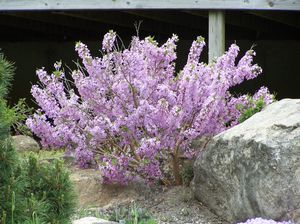View All Plants :: View All DECIDUOUS SHRUBS :: View All QUACKIN' GRASS INTRODUCTIONS
Daphne genkwa 'John Bieber'
Lilac Daphne
Plant Type:
DECIDUOUS SHRUBSDaphne genkwa 'John Bieber' (low form, purple flower) – Its May bloom on bare stems has the appearance of a showy low-growing lilac with the innumerable florets creating a cloud of purple without even a hint of pink. Relatively large matte finished lanceolate leaves up to 3-inches long follow. There had been a procumbent or prostrate form that had grown at NYBG; this is not that form. Ours is rather short in stature but with stems quite stiff and upright forming a flat-topped to rounded crown. John Bieber's eyes popped when I told him about this plant. I ascertained at that moment I had in my possession a special plant. John had been very helpful in sending us cuttings. We decided to name it for John who sadly recently passed away. This form as with other D. genkwa emits no fragrance. This unusual, more compact form of D. genkwa came to us either from Dick Redfield, a renowned rock gardener who lived nearby in Scotland, or from Environmentals, Inc., Jim Cross' renowned nursery situated in Cutchogue, Long Island. Though I have seen this listed as a part shade woodland plant that is content in even clay soils in my experience D. genkwa relishes full sun in neutral to lightly sweet draining gritty soil. In New Zealand D. genkwa is known as the Blue Daphne or Chinese Lilac.Thank you, John... we miss you. And Dick, too.
For a fun read see Daphne
More About Daphne genkwa 'John Bieber'
- EXCLUSIVE
| Item | Description | Price |
|---|
Characteristics and Attributes for Daphne genkwa 'John Bieber'
Season of Interest (Flowering)
- Spring
Season of Interest (Foliage)
- Spring / Summer / into Autumn
Nature Attraction
- Deer Resistant
Light
- Full Sun
Attributes
- Labyrinth
- Border
- Shrub Border
- Drought Tolerant
- Hedge
- Specimen
- Foundation
- Collector Plant
- Rock Garden
Growth Rate in the Garden
- Slow
Soil
- Sandy
- Calcareous
- Draining
- Average
- Scrabbled
Origins
- China
- Korea
Propagated By
- Cutting Grown
Genus Overview: Daphne
Daphnes are shrubby members of Thymelaeaceae. Many have thrived in our xeric garden which provides a deep root run, good drainage with no extra water during droughts. We add dolomitic limestone to the planting holes when initially interring them. Most have fragrance which is heavenly, perfuming the air near where they bloom. We have observed those that flower or rebloom in summer draw hummingbirds.
For all the discussion about their finicky personalities we have found them mostly quite easy to please in the ground though they, as a group, are largely not happy in containers for long; in containers death visits frequently - especially the yearlings - and it is as annoying as frustrating! As my good friend, Jonathan Lehrer, has told me on occasion, “Daphnes will never be a mainstream shrub because even the easy ones will up and die suddenly for no apparent reason.” My feeling is nothing goes on living forever; for all of their remarkable qualities they are worth growing for as long as they choose to be around! Certainly, the hybrids (x burkwoodii and x transatlantica) exhibit exceptional hybrid vigor, strength and ease of establishment.
Snow loads in the north can be an issue on taller growers, therefore, I suggest pruning older plants after flowering to ensure stouter, bushier shrubs that may better counteract weighty winter precipitation. After pruning they recover beautifully and quickly. Also, all that flower in summer are attractive to hummingbirds. Most of our selections come to us gratis from John Bieber who lives on Long Island, longtime lover of all things Daphne. Most of our Daphnes are cutting grown. There are exceptions including D. alpina which has been completely resistant from stem cuttings; these will be seed grown when we do have them available which may be infrequently!


